Japan has an impressive track record of keeping traditions alive for centuries, as can be witnessed all over the country. One such example includes the koinobori, also called the flying carp of Spring.
These artistic, colorful carp windsocks have been flown in Japan for centuries, and carry rich history and symbolism worth appreciating.
What Exactly Is A Koinobori?
A koinobori is a type of flag featuring koi-shaped windsocks. The structure consists of a long pole that has a rotating piece at the top that allows for the koinobori to spin based on the way the wind blows.
At the top of the koinobori, there is usually what is called a flying-dragon streamer, which is a bundle of colorful streamers.
Below this is typically where the carps are hanging. The word koinobori is made up of two Japanese words; koi meaning carp, and nobori meaning flag.
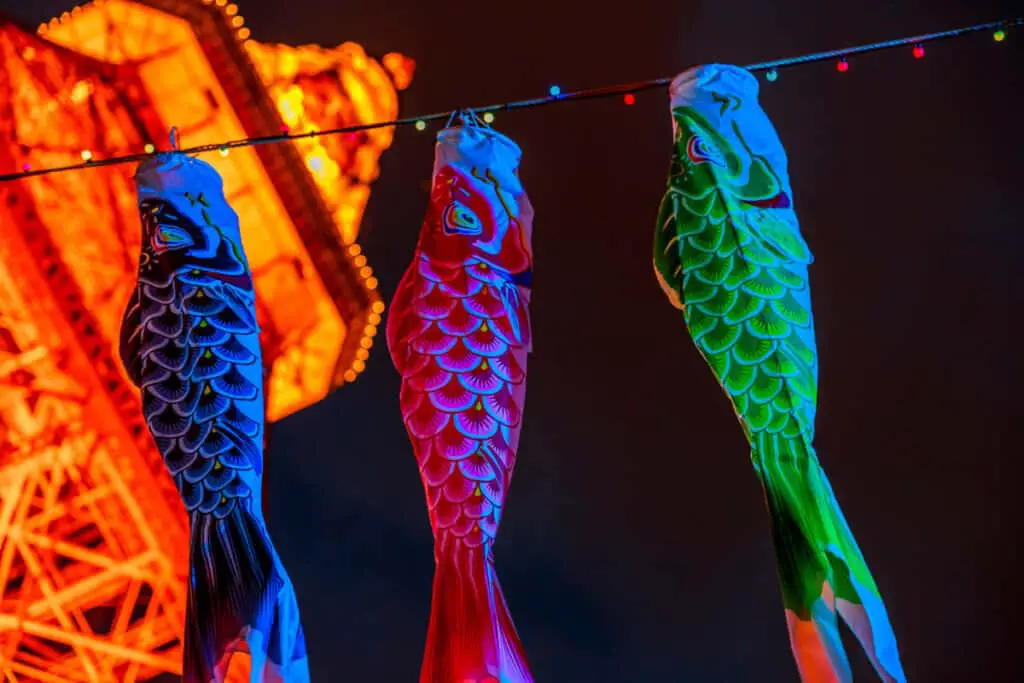
The Origin Of The Koinobori
The tradition of creating and displaying koinobori originated as part of the celebration of Boys’ Festival or Boys’ Day, which is now known as Children’s Day.
While this holiday is celebrated on May 5th, the koinobori will stay afloat from the beginning of April until the end of May.
In the age of the samurai, they would often have their own flags that they would erect on the battlefield. Carps started becoming a part of these flags during the Edo period of Japan.
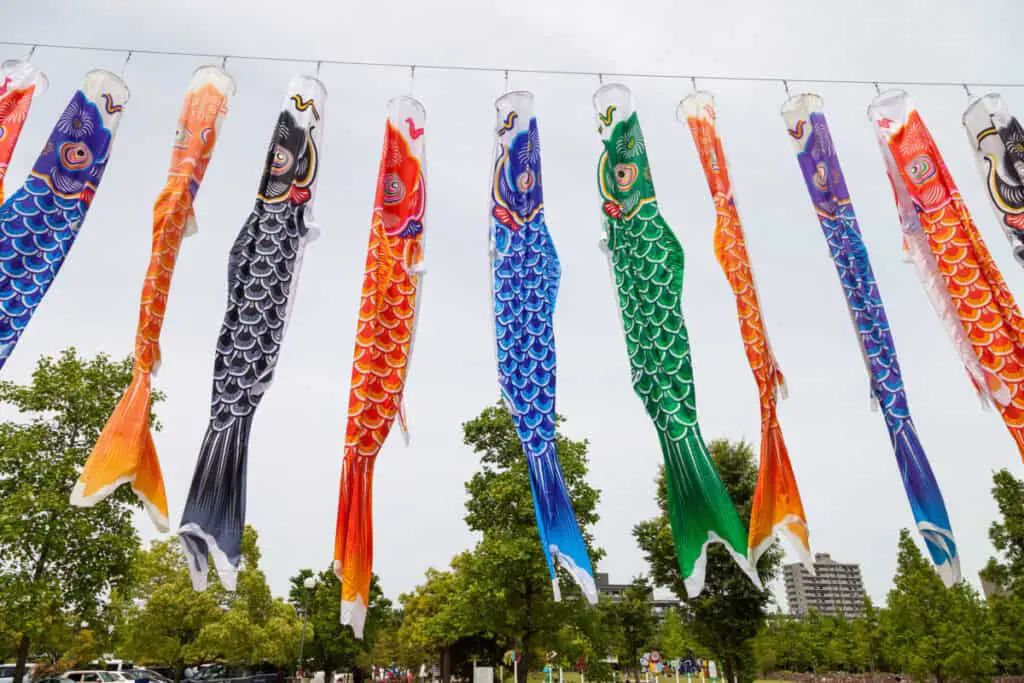
When the shogun, who were elite military members, decided to use flags with images of carps to commemorate newborn males in their families, the idea caught on.
The flags would be flown to not only celebrate these growing families but to symbolize their hope for prosperity and good fortune for these boys’ futures.
Being that this practice was first introduced by the shogun, it was considered as one only appropriate for these high-class members of society.
At some point, more people began constructing and displaying their own koinobori outside of their homes, and so the tradition became less elite and more accessible over the years.
Children’s Day (Formerly Boys’ Festival)
It is fairly well-known that historically in Japan, sons were highly desirable offspring, honored for being the carriers of the family’s name and genetics that were to be passed onto future generations.
Thus, this special day was celebrated in order to manifest hope for the future of the boys of Japan.
Being that a carp symbolizes steadfastness and bravery in Japan, it was fitting that the carp was chosen to be the symbol used to celebrate these young boys.
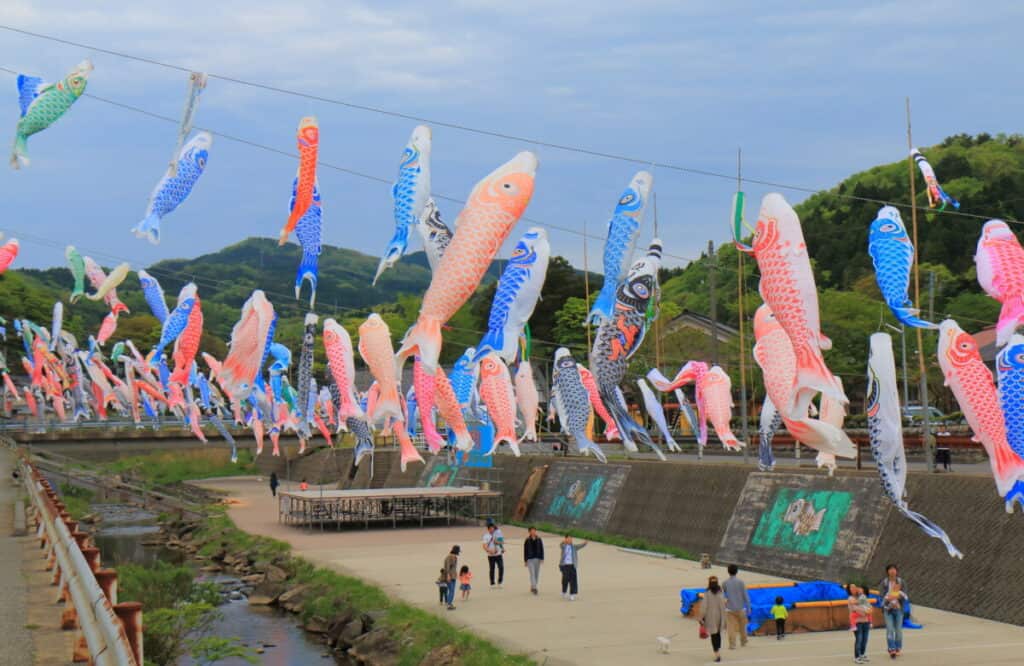
Since the holiday has evolved to include all children, the carp’s symbolism has become more inclusive to recognize the strength and importance of all children.
Apart from hoping for a positive future for children during this holiday, the holiday also celebrates how unique and special each child is, and celebrates the innocence and happiness of children.
It is also common for people to display samurai dolls and helmets in their homes on this day.
Festive fares are also enjoyed during this celebration, including kashiwa mochi, which is a sticky rice cake filled with red bean jam and wrapped in an oak leaf. Chimaki is also eaten, which is sweet sticky rice wrapped in either iris or bamboo leaves.
Boys’ Day changed to Children’s Day in 1948, which was the same year it became a national holiday instead of just a tradition.
Why Koi Fish?
Carps, known as koi in Japanese, are an important fish to Japan. The carp is a fish that represents strength and growth, which are two important values to Japanese people. Part of why carp are viewed in this high regard dates back to an old tale.
The tale goes that many fish were trying to make their way up the Koga River. All types of fish attempted this feat, but many unfortunately couldn’t keep up with the restless and strong currents.
However, a golden carp was able to complete the journey, resulting in a transformation into a beautiful dragon.
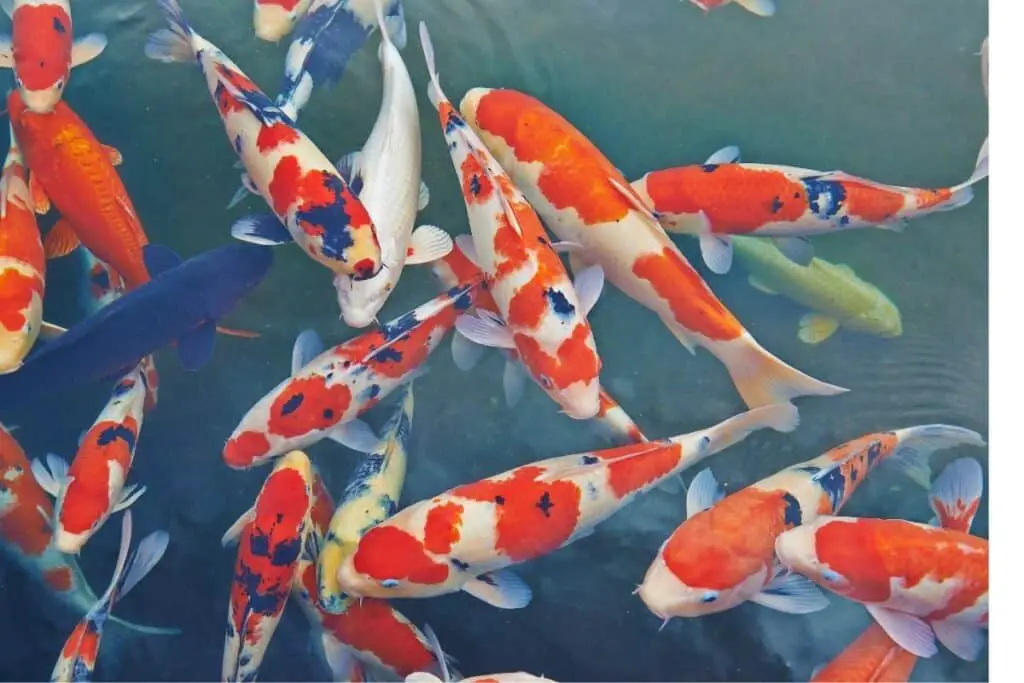
For many parents, their hopes are that their children will be able to overcome the obstacles put in their path, and will be able to become stronger people because of their success.
Parents in Japan saw the traits attributed to the carp as those that they would want their children to adopt.
Paying homage to koi in the manner of koinobori displays is one-way parents hope to instill and inspire these values in their kids.
Koi Fish Symbolism Outside Of Koinobori
Outside of koinobori, a koi fish, which was bred from traditional carp when brought to Japan, is recognized as a symbol of good luck. They are also known to be regarded as symbols of love and friendship.
They are distinct from other species of carp because of their vibrant coloring.
How Koinobori Have Changed Throughout The Centuries
At the very beginning of the use of koinobori, the windsocks were typically only black. This is the color that many wild carps are, so it made sense.
The Meiji era saw more colors being introduced to the windsock designs, including reds and oranges.
In the 1900s, the traditional set up of koinobori was established. This is still sometimes used today, but the rules for how koinobori are to be set up in modern times are less stringent.
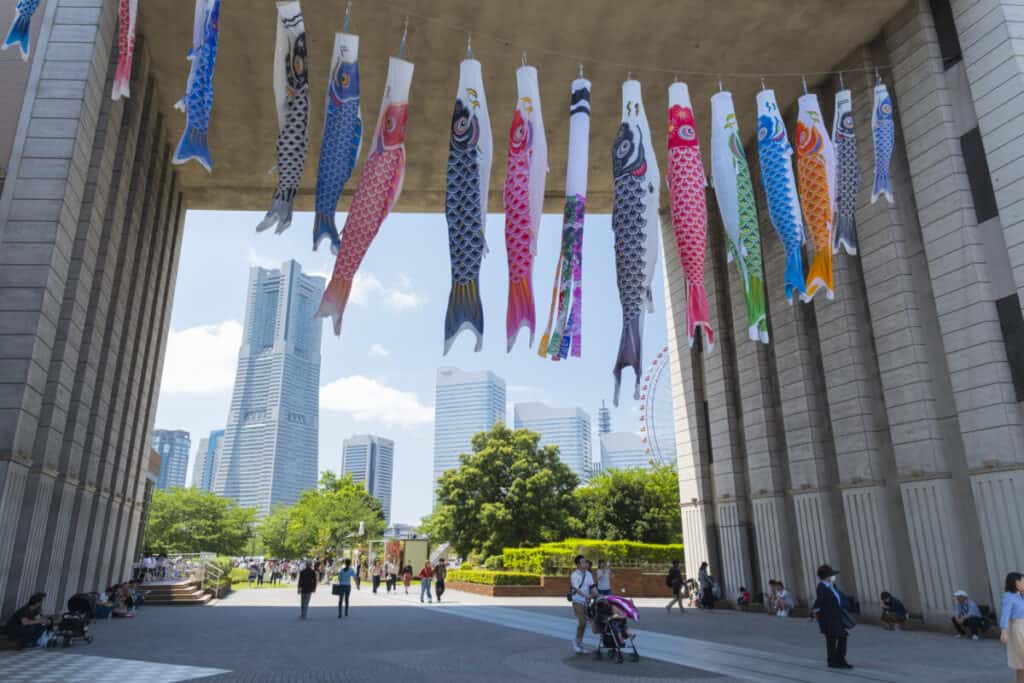
A Traditional Koinobori Set Up
A traditional koinobori set up would consist of specific carp that were certain sizes and certain colors to represent the members of the family. These would then be erected on the roof of the home.
There would be a black koinobori that symbolized the father of the family, and that fish would typically be bigger than the rest.
After that, there would be a red koinobori that is a little bit smaller than the black one, if there was a son in the family. If there were multiple sons, the red one would represent the oldest one.
The other sons would be represented by koinobori with different colors, cascading from green, blue, purple, and orange.
Regardless of how many carp were set up as part of a koinobori display, the pole would always be put up in such a way that the carp were all set up vertically.
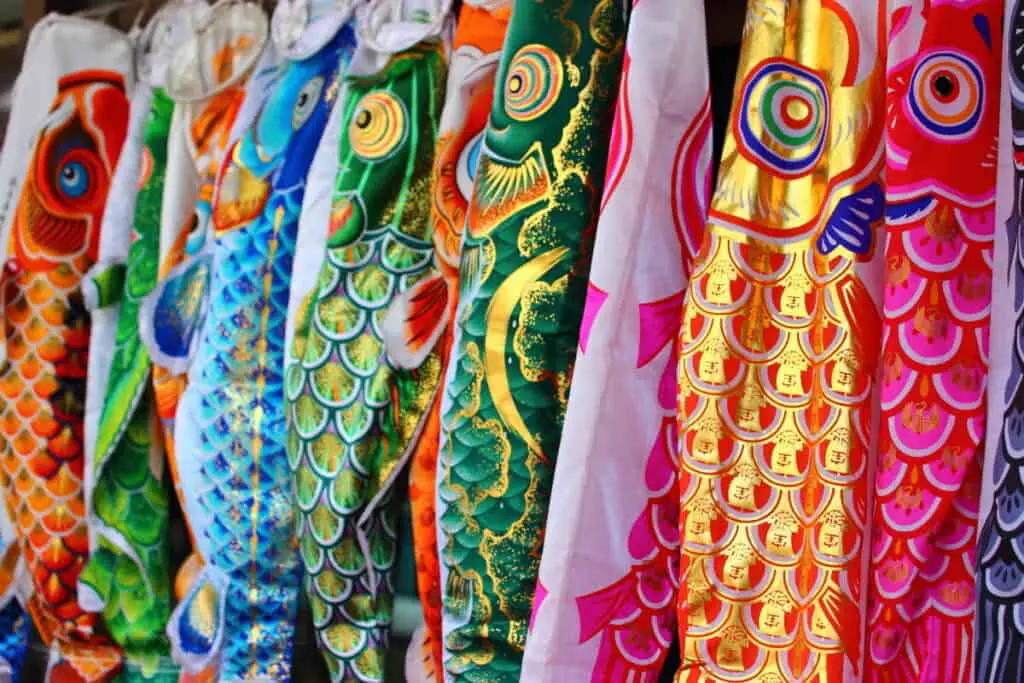
Modern Koinobori
Since the koinobori poles are no longer just set up to commemorate Boys’ Festival, given that it is now called Children’s Day, the set up is often different to include the mother and other children.
Furthermore, the koinobori that are set up during the Spring is not always as big and elaborate as they used to be.
Some people don’t have a big roof, or their own roof in the case of an apartment, to be able to hang a large koinobori on. Therefore, some will hang a small display on their balcony, while others will just make their own indoor koinobori.
Koinobori are also sometimes set up horizontally when put on display. These horizontal displays can be found all over Japan in the Spring.
There are even carp windsocks that you can purchase on a much smaller scale to bring home as a souvenir to remember your trip.
The Parts Of The Koinobori
The very top of the koinobori pole is called the yaguruma. This is the part that rotates with the wind, and has arrow-shaped spokes at the top. The fukinagashi is the set of streamers also referred to as the flying dragon streamer.
Following these two elements will be the carp, which could be set up in a number of ways to represent family, or multiple carps to symbolize children as a whole.
Notable Koinobori Displays Throughout Japan
The whole country tends to participate in making their own koinobori, leading to some breathtaking displays to be witnessed.
Regardless of where you might be visiting in Japan, you might have the opportunity to see one of these displays in all their glory.
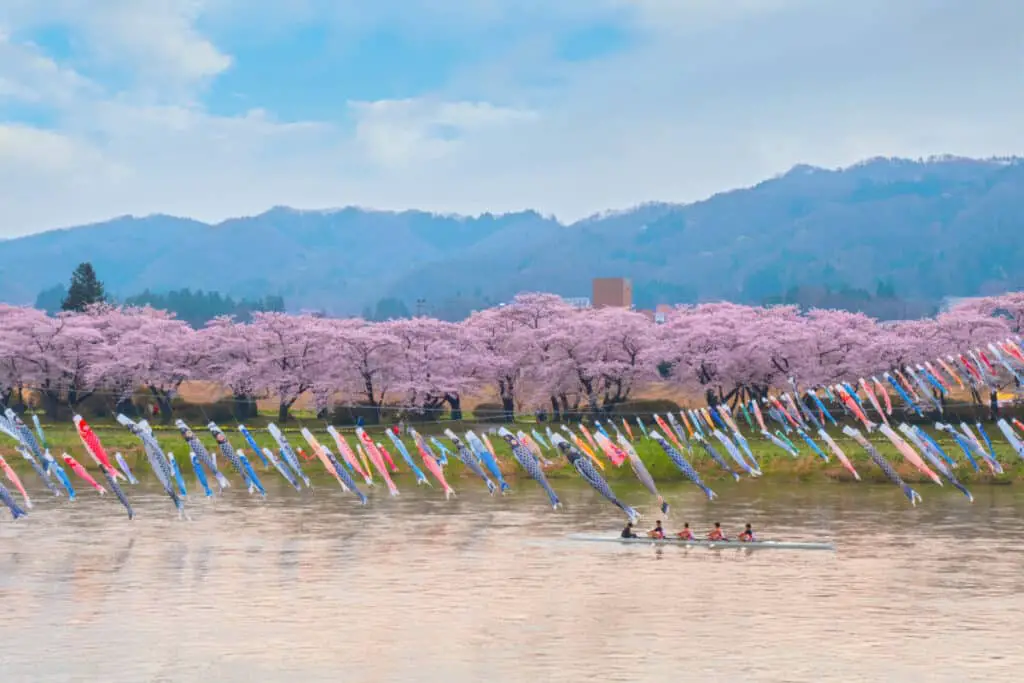
In the city of Tatebayashi in Gunma Prefecture, for example, you can find one of the most elaborate displays of koinobori each Spring.
The entire display will have over 5000 koi flying through the air. Aso in Kumao Prefecture comes in at a close second, with a display of 3500 koi being flown each year.
It is common to find koinobori displays being hung above areas of water, as is the case with the display hung above Toh River in Takaoka each year.










